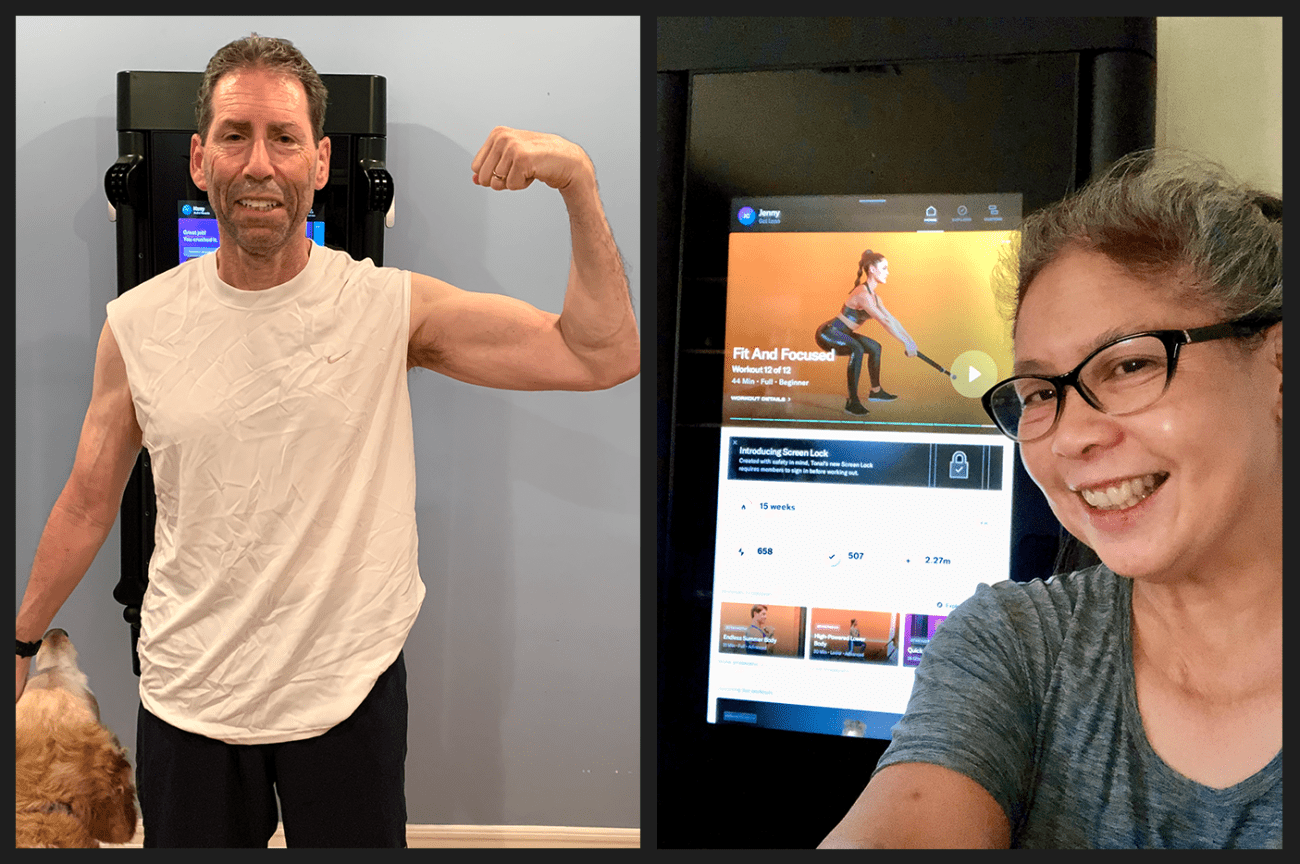
“I’m tougher than I think.”
That’s what Jennifer Contreras, 56, of California, discovered after 30 days of training like a pro athlete. Each month, the Official Tonal Community comes together to take on a challenge and complete one of our four-week, coach-led programs. July’s challenge, Train Like an Athlete, was led by former professional athlete and certified trainer Coach Paul Wright with his program: Good to Great.
Contreras joined the challenge because she signed up for a Tough Mudder race and wanted to be in good enough condition to hold her own alongside teammates 12 to 15 years younger. “I’ve been athletic [most] of my life, but for the past ten years, I’ve been dealing with injuries and had to rethink [my] exercise and fitness,” she said. “This challenge would allow me to explore new ways of moving that I wouldn’t normally choose.”
Others had different motivations. Harry Kraushaar, 66, also of California, is a former cardio lover who converted to strength training in 2020 thanks to Tonal. He signed up for the challenge to work out more closely with other members and Coach Paul.
All members were given a calendar of twice-daily workouts, recovery and hydration goals, and mindset work such as reading and journaling. Both Contreras and Kraushaar bravely signed up to document their experience. Here, they share what they learned from channeling their inner athlete for 30 days.
1. Mindset makes a difference.
At the start of the challenge, Coach Paul explained that cultivating good daily habits to take care of your mind, body, and soul is essential for an athlete. “It helps create space to focus, tap into that inner drive, and activate your inner athlete,” he said.
Challenge members had the option to read or journal for 30 days, and Kraushaar chose to join Tonal’s monthly book club, reading The Mindful Athlete by George Mumford. With time, the book’s tips began to sink into Kraushaar’s mind and empower him. For example, when he started experiencing tightness in his back during a workout, he normally would have pushed through, but decided not to—something he admits he wouldn’t have considered before. “I have only begun to learn more about mindfulness, but still have a long way to go, and [I’m looking] forward to adopting more of this [work] in my daily life,” Kraushaar says.
2. Mobility is a game changer.
Recovery is essential for anyone who works out. During the challenge, one of the twice-daily workouts was usually mobility or recovery-based.
Contreras, a busy chef, said discovering a slew of mobility workouts thanks to the challenge was one of the best parts, and she was pleasantly surprised by all of them despite thinking that yoga would be her biggest test. “Having a variety of workouts has allowed me to look at my own fitness and realize what my weak points are,” she said.
Going forward, Contreras plans to make more time for recovery. “[Mobility] seemed to be the missing piece of what my body needed,” she added.
3. Listen to your body.
Kraushaar says one of his quirks is that he no longer has specific exercise goals. “I don’t care about building muscle mass, getting stronger, or dramatically altering my body composition,” he said. In his thirties, he was a swimmer on a master’s team and participated competitively in triathlons, bike centuries, ocean swims, and various marathons and races.
After being so goal-oriented, he now focuses solely on the joy of exercising. “The satisfaction I used to get from achieving more specific goals was fleeting, at best. [Now,] when I work out, I ignore most outside stimuli and focus inward, generally on the beat of my heart,” he said. For Kraushaar, listening to his body throughout the challenge meant doing the work. It was the only win he wanted and the only one he cared about.
For Contreras, her physically-demanding job meant she had to learn to be in tune with her body in a different way. Late-night shifts meant not getting enough sleep, which sometimes made it challenging and exhausting to get through the workouts. “Doing them left me more energized than before I started,” she explained.
While proud of completing all the workouts, this challenge taught Contreras she needs to do a better job of listening to her body, especially when tired. “[I need] to rest and recover without feeling like I failed to complete a workout if I take a day off,” she said.
4. Celebrate where you are.
At the end of the challenge, Contreras found herself in a completely different place. “It almost feels like I’ve stepped into my power,” she said. “I can say I am an athlete. Reaching the end of the challenge feels awesome.”
Kraushaar feels he is fitter than he has been in decades and can recover better. The challenge has also restored some confidence in his abilities as a 66-year-old. “I enjoyed pushing myself to stay focused,” he said. “I am a bit fitter and more confident that I can [go] harder on Tonal than I have in the past, possibly even trying some of the hardcore programs. I especially like the improvements I have made in my burpees. I didn’t expect to work out my core so much and [appreciate] the stability it’s given me in all the movements.”
This challenge may be over, but you can still Train Like an Athlete. You’ll find a detailed workout calendar, progress tracker, tips, and recommendations here.